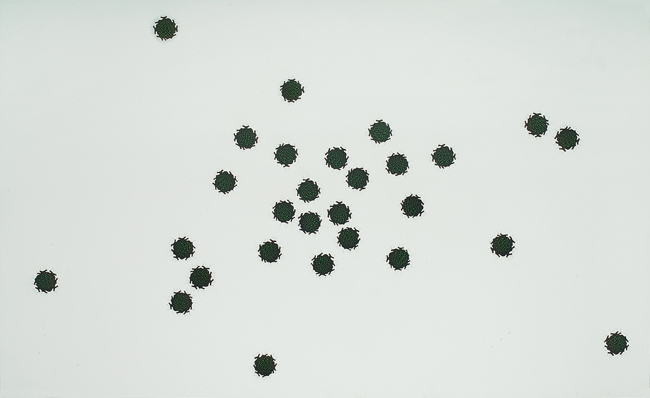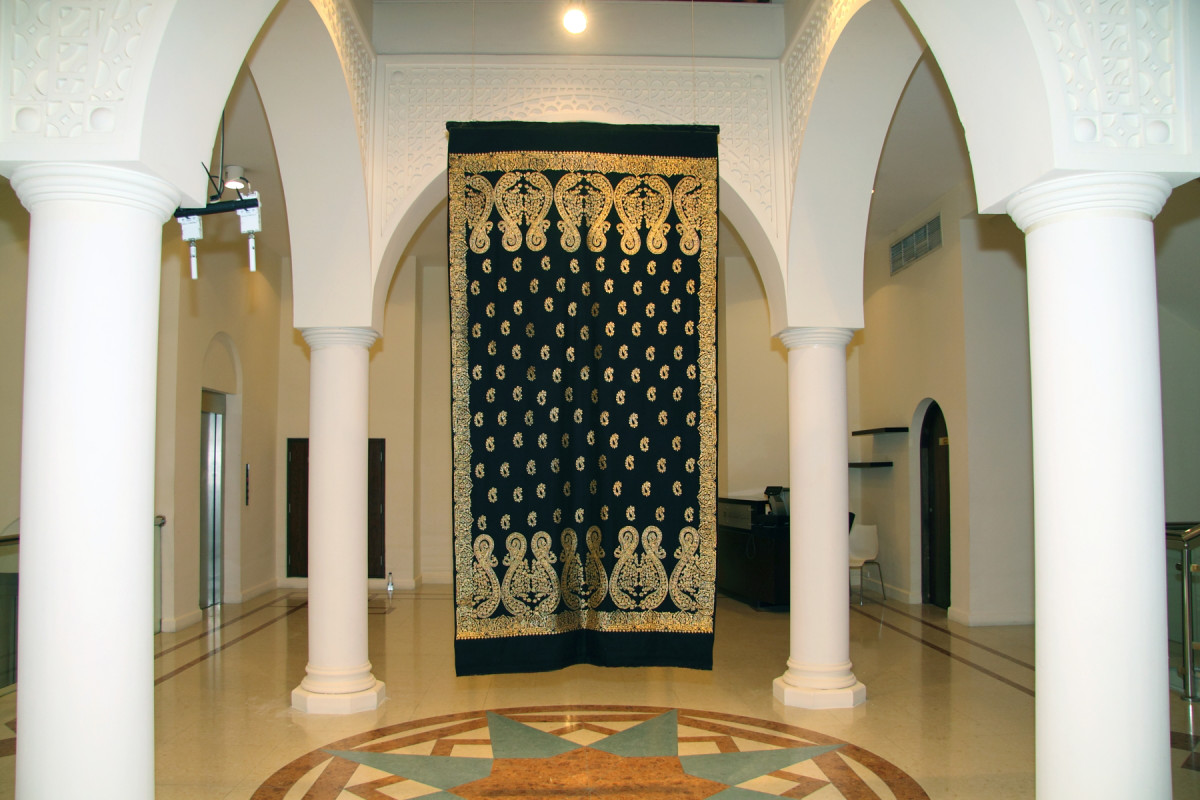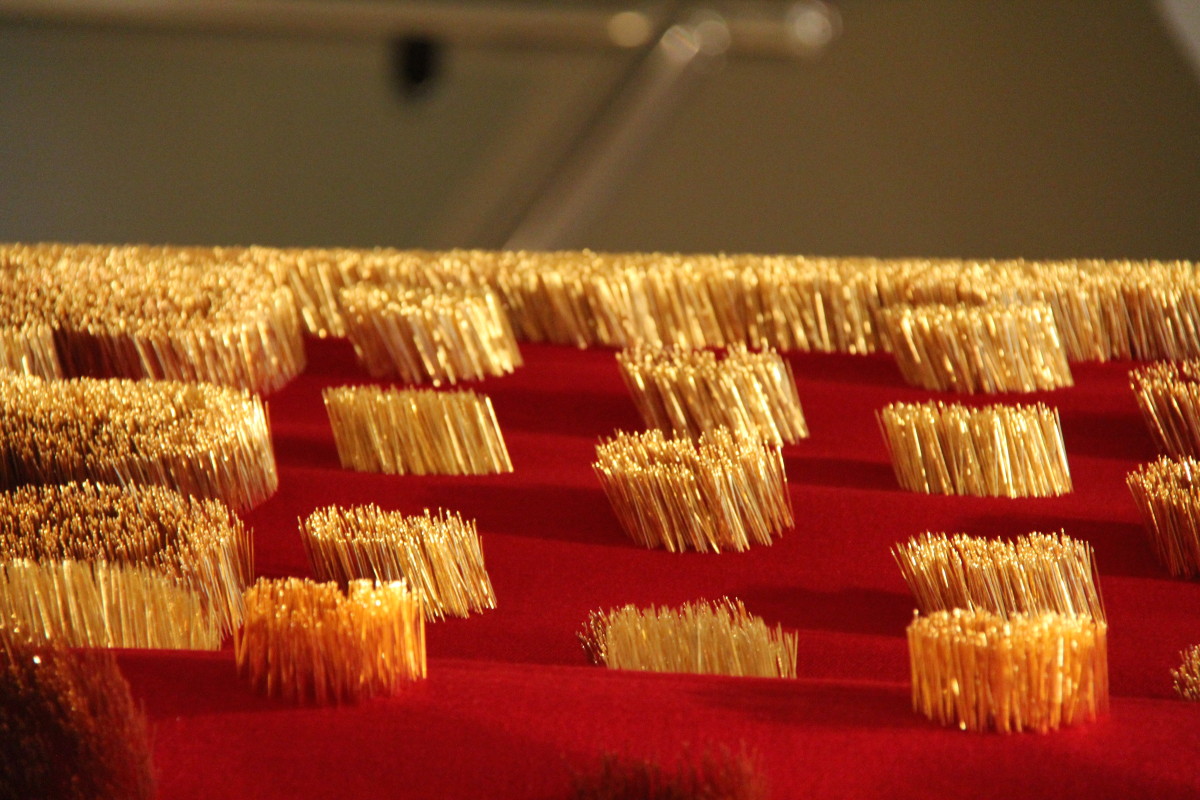Sabine B. Vogel: Why do you use ornament in your work?
Aisha Khalid: I graduated from the National College of Arts with a degree in miniature painting in 1997. This technique is one of the most sophisticated of Indo Mughal art practices. I use this traditional technique to create my paintings and use the same surface that was used historically. Layers upon layers of paper are pasted together to create this surface. The culmination of this process is a surface called ‘Wasli’.
Mughal miniature paintings were usually bound together in the form of albums or books. These books comprised of paintings and calligraphy including Quranic illustrations as well as historical and scientific documentation. Ornamentation was a key element in decorating the illustrations in this book.
The use of ornament is not restricted to the creation of art, it pervades our entire traditional and popular culture. It is found on patterns on the floor, in embroidery on fabric and architectural details. Everything is embellished with patterns – and each pattern has its particular meaning. Floral and foliate patterns have a special significance as decorative elements as they symbolize hope and life. Furthermore, there is an abundance of ornamentation in Western art as well. Though post-war, artists in the West have not used Ornaments in their work. It is as if there is a reservation against beauty. Maybe the view is that ornamentation is blasé – and this was the impression I got during my time in Amsterdam. The tradition of enjoying beauty and the pleasure derived from it seems to have been lost. This may be related to the development of industry and technology.
SBV: Do you use ornament also in this sense as a symbol or visual sign for the Islamic culture?
Aisha Khalid: My work is conceptually and visually inspired by the Islamic art of geometrical patterns. These are usually inspired by nature and logic. I developed patterns and used these in an innovative way, and therefore my work is contemporary in its formulation. I believe it is a pertinent example of a ‚living tradition‘ or ‚Islamic Cultural Heritage‘. This practice is based on accuracy and perfection and that I’d like to make this clear in my work.

exhibition „Power of Ornament“, Belvedere, 2011, on the right side Aisha Khalid (floor: Sakshi Gupta, left: Raqib Shaw; curated by Sabine B. Vogel)
I have been working with geometrical patterns for the last ten years. Initially the patterns that emerged in my work were derived from those on the floor of my childhood home. I had started making squares and dividing them by layers of colours and started creating my own geometrical grids. The work that emerged was abstract but the narrative was social, political as well as personal.
In my recent work, my main focus is on classical Islamic geometrical patterns. Mostly these Islamic patterns are based on the formation of lines and therefore the line becomes a very important element of the pattern. I am so inspired that sometimes I feel if I take just one pattern out of them and work with it, I would be able to explore it for my entire life. There is a deep spirituality in this, based on logic and mathematical precision.
The creation of the world is based on Geometry and Mathematics, which inspires me as an artist, and the cosmos, the universe and movement of the planets and the solar system are an inspiration as well. That is why these visuals have found their way into my recent works of art.
SBV: Does your ornament have a special meaning?
Aisha Khalid: The star was the first form I used, as it is central to Islamic geometry, and it was part of my memories of my childhood home. I also use floral patterns or flowing lines to symbolize water. In Kabul I first painted a shape composed of geometrical patters reminiscent of a bullet hole – war is omnipresent in Kabul, I had to respond to it.
SBV: Doesn’t this constitute a sharp contrast, if you in your work lend such beauty to the destruction by bullets?
Aisha Khalid: I would like to explain it like by giving a literary example. It is similar to the pain and misery expressed by poets in words full of beauty. It is not my intention to simply show things as they are but to present them in such a way that the viewer reflects on and contemplates the work. And above all, I do not want to reiterate the negative, but want to oppose it.
The Kabul exhibition travelled to Venice. The work now had a new meaning as it was based in Europe and would confront the European public. In the work Face it I didn’t paint the bullet holes onto the wall but onto mirrors – the shapes were projected onto the bodies of the viewers, covering the whole room.
For another exhibition I created the coat, which was a very personal work. The patterns were composed of needles. From the outside it looks very beautiful, but another story is revealed on the inside. When the opening reveals the inside of the sleeves and the coat the ornament reveals its ferociousness.
In another such work, which I created for the Sharjah Biennial, I worked on a large Kashmiri shawl. This work is inspired by Kashmiri pashmina shawls which are popular all over the world for the quality of their wool and exquisite designs.
This work is made up of actual Kashmiri shawls and is embroidered with gold plated steel pins. The pattern is composed of a traditional paisley pattern that is indigenous to Kashmir. This work will hang in the middle of the atrium of the Sharjah Art Museum. The black parts of the shawl are decorated with metal embroidery made of pin heads; a merger of tradition and beauty. The Kashmiris express this in their shawls while living in Indian occupied Kashmir. The other side is red and it has the steel pins projecting from it. This narrative aims to tell the hidden story of the Kashmiri people who have been suffering for years under the control of the Indian army. People talk about the beauty of the shawls but are indifferent to the plight of the Kashmiri people.
SBV: Thanks a lot!
Interview for the catalogue of „Political Patterns„, ifa Gallery Berlin, Stuttgart, 2011. curated by Sabine B. Vogel




